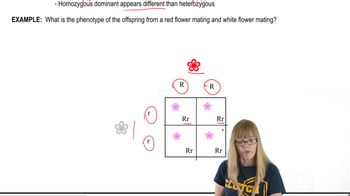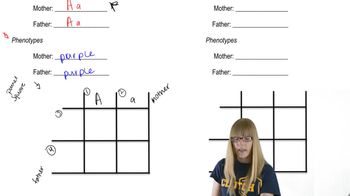Table of contents
- 1. Introduction to Genetics51m
- 2. Mendel's Laws of Inheritance3h 37m
- 3. Extensions to Mendelian Inheritance2h 41m
- 4. Genetic Mapping and Linkage2h 28m
- 5. Genetics of Bacteria and Viruses1h 21m
- 6. Chromosomal Variation1h 48m
- 7. DNA and Chromosome Structure56m
- 8. DNA Replication1h 10m
- 9. Mitosis and Meiosis1h 34m
- 10. Transcription1h 0m
- 11. Translation58m
- 12. Gene Regulation in Prokaryotes1h 19m
- 13. Gene Regulation in Eukaryotes44m
- 14. Genetic Control of Development44m
- 15. Genomes and Genomics1h 50m
- 16. Transposable Elements47m
- 17. Mutation, Repair, and Recombination1h 6m
- 18. Molecular Genetic Tools19m
- 19. Cancer Genetics29m
- 20. Quantitative Genetics1h 26m
- 21. Population Genetics50m
- 22. Evolutionary Genetics29m
2. Mendel's Laws of Inheritance
Monohybrid Cross
Problem 9b
Textbook Question
In the datura plant, purple flower color is controlled by a dominant allele P. White flowers are found in plants homozygous for the recessive allele p. Suppose that a purple-flowered datura plant with an unknown genotype is self-fertilized and that its progeny are 28 purple-flowered plants and 10 white-flowered plants.
Use the results of the self-fertilization to determine the genotype of the original purple-flowered plant.
 Verified step by step guidance
Verified step by step guidance1
<span>Step 1: Understand the genetic basis of flower color in datura plants. The purple flower color is controlled by a dominant allele P, while the white flower color is controlled by a recessive allele p. Therefore, a plant with purple flowers can have either the genotype PP (homozygous dominant) or Pp (heterozygous).</span>
<span>Step 2: Analyze the progeny results. The progeny consists of 28 purple-flowered plants and 10 white-flowered plants. This indicates a phenotypic ratio of approximately 3:1 (purple to white).</span>
<span>Step 3: Determine the possible genotypes of the original purple-flowered plant. If the original plant were homozygous dominant (PP), all progeny would have purple flowers. However, since there are white-flowered progeny, the original plant must be heterozygous (Pp).</span>
<span>Step 4: Use a Punnett square to confirm the genotype. Set up a Punnett square with the genotype Pp (for the original plant) crossed with itself (self-fertilization). The expected genotypic ratio from this cross is 1 PP : 2 Pp : 1 pp, which corresponds to a phenotypic ratio of 3 purple : 1 white.</span>
<span>Step 5: Conclude that the original purple-flowered plant is heterozygous (Pp) based on the observed 3:1 phenotypic ratio in the progeny, which matches the expected outcome for a Pp x Pp cross.</span>
Recommended similar problem, with video answer:
 Verified Solution
Verified SolutionThis video solution was recommended by our tutors as helpful for the problem above
Video duration:
2mPlay a video:
Was this helpful?
Key Concepts
Here are the essential concepts you must grasp in order to answer the question correctly.
Dominant and Recessive Alleles
In genetics, alleles are different forms of a gene. A dominant allele, represented by a capital letter (e.g., P), masks the effect of a recessive allele (e.g., p) when both are present. In the case of the datura plant, the presence of at least one dominant allele results in purple flowers, while only the homozygous recessive genotype (pp) produces white flowers.
Recommended video:
Guided course

Variations on Dominance
Genotype and Phenotype
The genotype refers to the genetic makeup of an organism, while the phenotype is the observable physical trait resulting from the genotype. In this scenario, the purple-flowered datura plant can have either a homozygous dominant genotype (PP) or a heterozygous genotype (Pp), both resulting in the purple phenotype. Understanding this distinction is crucial for determining the original plant's genotype based on progeny ratios.
Recommended video:
Guided course

Gamete Genotypes
Punnett Square and Progeny Ratios
A Punnett square is a tool used to predict the genotypes of offspring from a genetic cross. In this case, the ratio of purple to white flowered progeny (28:10) can be simplified to approximately 7:2. This ratio suggests that the original purple-flowered plant was likely heterozygous (Pp), as a cross between two Pp plants would yield a 3:1 ratio of purple to white flowers, consistent with the observed progeny.
Recommended video:
Guided course

Chi Square Analysis

 1:20m
1:20mWatch next
Master Monohybrid Cross with a bite sized video explanation from Kylia Goodner
Start learningRelated Videos
Related Practice


